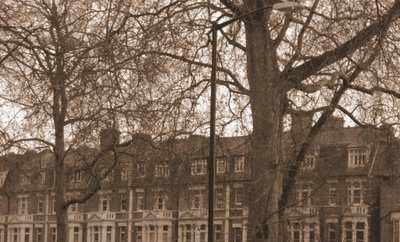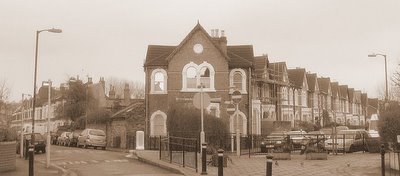Friday, February 03, 2006
Around here

It’s an almost intact Victorian suburb. Here and there a block of flats or a few new houses, built on what was a garden too large for today’s tastes. Here and there a group of prefabs where a bomb fell more than sixty years ago – meant to last ten years and still, astonishingly, serving someone well. But these are few, amid mile after mile of red-brick terraces – large and small, two storeys, three storeys, four, some with carved wooden gable-edges or fancy plaster-work and some without, some still single-family houses and some chopped into two or three apartments. Solid and in good condition after much more than a hundred years, with their big windows and high ceilings, overlooking widish roads and generous gardens. It’s all on a human scale and rather soothing in its uniformity.



The Victorians built parks too; within a mile or so of here are two large green spaces, laid out along with the first housing estates, with huge old trees, lawns and lakes now undergoing expensive restoration. For we are restoring, gentrifying, going up market finally. Long a shabby, unmodish area because there is no tube link, the journey to work in Central London a lengthy, congested bus-ride through depressed inner city, we are becoming fashionable at last. Cheap property brought young professionals, single house-sharers and couples with small children - not the affluent, but not so poor either - and new businesses sprang up to cater to them. The tatty butchers and greengrocers closed down and re-opened as silly, sparkly trinket shops, the pubs sprouted new facades and tapas menus. Then the trinket shops turned back into butchers and greengrocers – expensive organic ones – and we were really on our way. Half the front gardens have been bulldozed and concreted over for car-parking, laden builders’ skips clutter up the streets as wooden floors and ‘shaker’ kitchens are installed, loft conversations rise and conservatories sprawl.

It’s all much better than depression and decay – a modest, decent place to live, just as it was when new. It’s a dormitory, though, not a community. A lot of uncared-for ugliness flourishes between the titivated houses and there’s a tacky fragility to the bright new shop-fronts. A Victorian suburb is at heart a grey-brown, gloomy place. And more starkly gloomy, perhaps, under sodium streetlamps, than ever it was by gaslight.

It’s an almost intact Victorian suburb. Here and there a block of flats or a few new houses, built on what was a garden too large for today’s tastes. Here and there a group of prefabs where a bomb fell more than sixty years ago – meant to last ten years and still, astonishingly, serving someone well. But these are few, amid mile after mile of red-brick terraces – large and small, two storeys, three storeys, four, some with carved wooden gable-edges or fancy plaster-work and some without, some still single-family houses and some chopped into two or three apartments. Solid and in good condition after much more than a hundred years, with their big windows and high ceilings, overlooking widish roads and generous gardens. It’s all on a human scale and rather soothing in its uniformity.



The Victorians built parks too; within a mile or so of here are two large green spaces, laid out along with the first housing estates, with huge old trees, lawns and lakes now undergoing expensive restoration. For we are restoring, gentrifying, going up market finally. Long a shabby, unmodish area because there is no tube link, the journey to work in Central London a lengthy, congested bus-ride through depressed inner city, we are becoming fashionable at last. Cheap property brought young professionals, single house-sharers and couples with small children - not the affluent, but not so poor either - and new businesses sprang up to cater to them. The tatty butchers and greengrocers closed down and re-opened as silly, sparkly trinket shops, the pubs sprouted new facades and tapas menus. Then the trinket shops turned back into butchers and greengrocers – expensive organic ones – and we were really on our way. Half the front gardens have been bulldozed and concreted over for car-parking, laden builders’ skips clutter up the streets as wooden floors and ‘shaker’ kitchens are installed, loft conversations rise and conservatories sprawl.

It’s all much better than depression and decay – a modest, decent place to live, just as it was when new. It’s a dormitory, though, not a community. A lot of uncared-for ugliness flourishes between the titivated houses and there’s a tacky fragility to the bright new shop-fronts. A Victorian suburb is at heart a grey-brown, gloomy place. And more starkly gloomy, perhaps, under sodium streetlamps, than ever it was by gaslight.
Comments:
<< Home
Marvelous photographs. I love that second one for its composition and story telling. This is an astute description of a neighborhood.
Lovely photos, especially being sepia! You've described such beauty, but some ugliness too, I suppose that's life. I wonder how it could become a community? It seems to be a problem in our car-oriented society, doesn't it?
A rich & lyrical celebration of domestic Victoriana. And, yes, the sepia pictures are a suitably sombre accompaniment.
Post a Comment
<< Home



